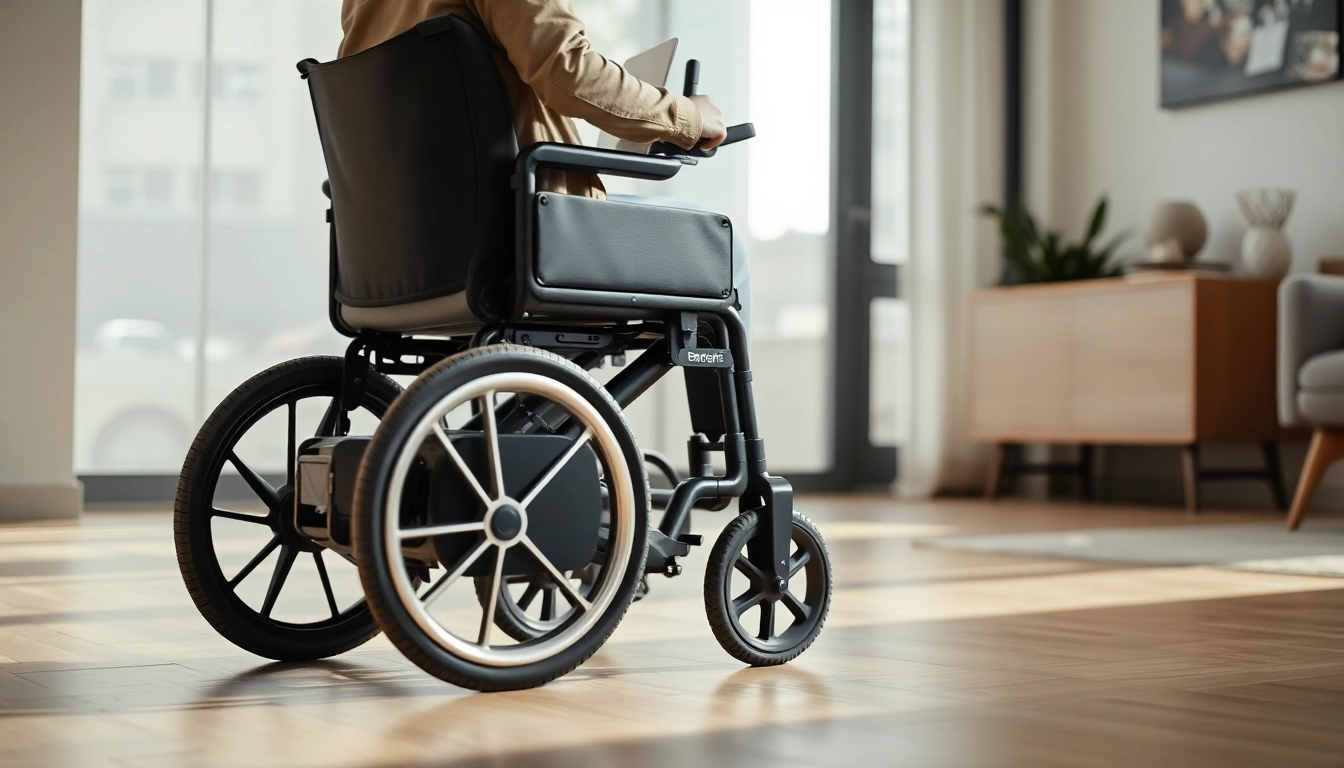Understanding Power Wheelchairs
What Is a Power Wheelchair?
A power wheelchair, also known as an electric wheelchair, is a mobility device designed for individuals who have difficulty walking due to health-related challenges or disabilities. Unlike manual wheelchairs, which require physical effort to propel, power wheelchairs use an electric motor and batteries to facilitate movement, providing users the independence and ability to navigate their environment with ease. This technology often includes intuitive controls, such as a joystick or touchpad, enabling users to operate their chair with minimal effort. Power wheelchairs are particularly valuable for people with mobility impairments, allowing them access to a broader range of activities and locations.
Types of Power Wheelchairs and Their Uses
There are several types of power wheelchairs, each designed to cater to differing mobility needs and environments. The main types include:
- Standard Power Wheelchairs: Ideal for indoor and flat outdoor surfaces, these models typically have a weight capacity of around 300 to 500 pounds and are designed for everyday use.
- Heavy-Duty Wheelchairs: Designed for users requiring additional strength and durability, these wheelchairs can support higher weight capacities and often include reinforced frames and enhanced motors.
- All-Terrain Power Wheelchairs: Suitable for rough terrains, these models come with larger wheels and enhanced suspension systems, enabling users to navigate uneven surfaces like gravel or dirt.
- Medical Power Wheelchairs: Specifically designed for individuals with complex medical conditions, these wheelchairs often feature specialized seating systems and adjustable positioning to ensure comfort and postural support.
Key Features of Modern Power Wheelchairs
Modern power wheelchairs come equipped with numerous features aimed at enhancing usability, comfort, and flexibility. Some of the key features include:
- Adjustable Seating: Many power wheelchairs now offer customizable seating options to provide optimal comfort and support, crucial for long-term use.
- Swing-Away Footrests: This feature allows users to enter or exit the wheelchair more easily, enhancing accessibility.
- Power Seating Functions: Some models allow users to tilt, recline, or elevate their seat, providing additional comfort and assisting with certain medical conditions.
- Smart Technology: Advanced models include technology such as Bluetooth connectivity, allowing users to control their chairs via smartphone apps.
- Safety Features: Options like anti-tipper wheels and automatic brakes enhance user safety, especially on slopes or uneven surfaces.
Benefits of Using a Power Wheelchair
Improved Mobility and Independence
One of the most prominent benefits of using a power wheelchair is the significant enhancement of mobility and independence it offers. Users can easily travel over various terrains, access different environments, and engage fully in everyday activities without relying on caregivers. This increased freedom can significantly improve the quality of life for individuals with mobility challenges, fostering a sense of normalcy and autonomy.
Health Benefits of Power Wheelchair Use
The health implications of using a power wheelchair go beyond mere mobility. For many individuals, enhanced mobility leads to increased physical activity, which can have several health benefits:
- Reduction in Secondary Complications: Spending long periods in a traditional wheelchair can lead to complications like pressure sores or muscle atrophy. Power wheelchairs often come equipped with features that promote movement and better posture.
- Improved Psychological Well-Being: Having the independence to move freely can lead to improved mental health, with many users reporting reduced feelings of depression or anxiety.
- Physical Conditioning: Although power wheelchairs lessen the need for physical exertion, many models encourage some level of user engagement, whether it’s moving the joystick or managing terrain challenges, which contributes to overall wellness.
Cost-Effectiveness and Long-Term Value
While the initial investment in a power wheelchair can be substantial, the long-term value it offers often outweighs the costs. Factors contributing to this cost-effectiveness include:
- Medication and Healthcare Savings: Improved mobility can lead to fewer medical complications and a decrease in associated medical costs, ultimately saving users money over time.
- Enhanced Life Quality: The benefit of increased access and independence fosters a lifestyle that often results in less missed work or social opportunities, contributing positively to one’s overall quality of life.
- Insurance Coverage: Many health insurance policies offer coverage for power wheelchairs, reducing the upfront costs for eligible recipients.
Selecting the Right Power Wheelchair
Assessing Your Mobility Needs
Choosing the right power wheelchair is crucial and begins with assessing your mobility needs. Factors to consider include:
- Physical Limitations: Consider the extent of your mobility issues. This includes your strength, balance, and ability to operate manual controls.
- Living Environment: Assess the layout of your home and frequently visited places. Tight spaces may require narrower models, while outdoor use might necessitate all-terrain capabilities.
- Activities and Lifestyle: Understanding how you plan to use the wheelchair can guide your selections; for instance, if you enjoy outdoor activities, look for options equipped for rough terrain.
Key Features to Look For
When selecting a power wheelchair, it is essential to consider specific features that align with your needs. These include:
- Battery Life: Evaluate the wheelchair’s battery range to ensure it meets your daily travel needs without frequent recharging.
- Weight Capacity: Ensure the wheelchair supports your weight comfortably, allowing for additional equipment or accessories if needed.
- Ease of Use: Opt for user-friendly controllers and controls, ensuring a simple operating process that can be mastered quickly.
- Warranty and Support: Consider models that offer comprehensive warranties and customer support services, ensuring you are covered for repairs and maintenance.
How to Test a Power Wheelchair Effectively
Before committing to a purchase, it’s essential to test a power wheelchair to ensure it meets your needs. Here are tips for an effective test:
- Try Different Surfaces: Test the wheelchair across varied surfaces, like carpet, tile, and outdoor terrain, to gauge its performance.
- Check Maneuverability: Assess how well you can navigate through tight spaces and corners, ensuring it suits your living environment.
- Evaluate Comfort: Spend sufficient time in the chair to determine whether the seating and positioning are comfortable for prolonged use.
Maintenance Tips for Your Power Wheelchair
Routine Maintenance Checklist
Maintaining your power wheelchair is crucial for ensuring longevity and functionality. A routine maintenance checklist should include:
- Battery Care: Check battery health regularly, ensuring connections are secure and terminals are free from corrosion.
- Wheel Checks: Inspect the wheels for wear and tear, ensuring they are appropriately inflated to enhance performance.
- Frame Inspection: Look for any signs of damage or wear on the frame, especially after outdoor use.
Common Issues and Troubleshooting
Power wheelchairs, while generally reliable, may encounter issues over time. Common problems include:
- Battery Failure: If the wheelchair stops working suddenly, it may be due to a drained or defective battery. Ensure it is charged and consider replacement if issues persist.
- Controller Malfunction: If the chair is unresponsive, check the connections. Sometimes, the joystick can get stuck or may need recalibrating.
- Physical Damage: If there are noticeable damages to the wheels or frame, consult with a professional for repair options.
When to Seek Professional Help
While routine maintenance can resolve most issues, some circumstances necessitate professional assistance. Seek help if:
- The wheelchair shows signs of significant wear or malfunction that you cannot fix.
- The battery management system is confusing, or there are persistent charging issues.
- Physical anomalies arise that could lead to injury if not addressed professionally.
Latest Innovations in Power Wheelchair Technology
Smart Features Revolutionizing Power Wheelchairs
The integration of smart technology into power wheelchairs is a game-changer, leading to enhanced control, safety, and user experience. Features such as:
- AI Integration: Some power wheelchairs now include artificial intelligence that learns the behavioral patterns of users to provide personalized navigation features.
- GPS Navigation: Advanced models come with built-in GPS systems, helping users navigate unfamiliar areas confidently.
- IoT Connectivity: Being part of the Internet of Things allows users to connect their wheelchairs to smart home systems, increasing overall functionality.
Eco-Friendly Designs and Sustainability
As the world gravitates towards sustainability, many manufacturers are committing to eco-friendly designs. Innovations in this area include:
- Recycled Materials: The use of sustainable materials in the manufacturing process is rising, helping reduce environmental impact.
- Energy-Efficient Batteries: Modern power wheelchairs often utilize lithium-ion batteries, which provide longer usage times while being more environmentally friendly compared to traditional batteries.
- Recyclable Components: Many companies are designing components that are easily recyclable, promoting a circular economy in the mobility sector.
The Future of Power Wheelchair Development
The future lies in greater user customization, secure tech integrations, and adaptability to varying physical needs. Trends projected for the development of power wheelchairs include:
- Modular Designs: Creating power wheelchairs with interchangeable parts to adapt to various user needs and increasing longevity.
- Enhanced User Interfaces: Future wheelchairs may include interfaces that respond to user thoughts to control movement, advancing accessibility significantly.
- Collaboration with Mobility Services: Innovations will likely integrate more seamlessly with transportation and community mobility services, maximizing user convenience.



